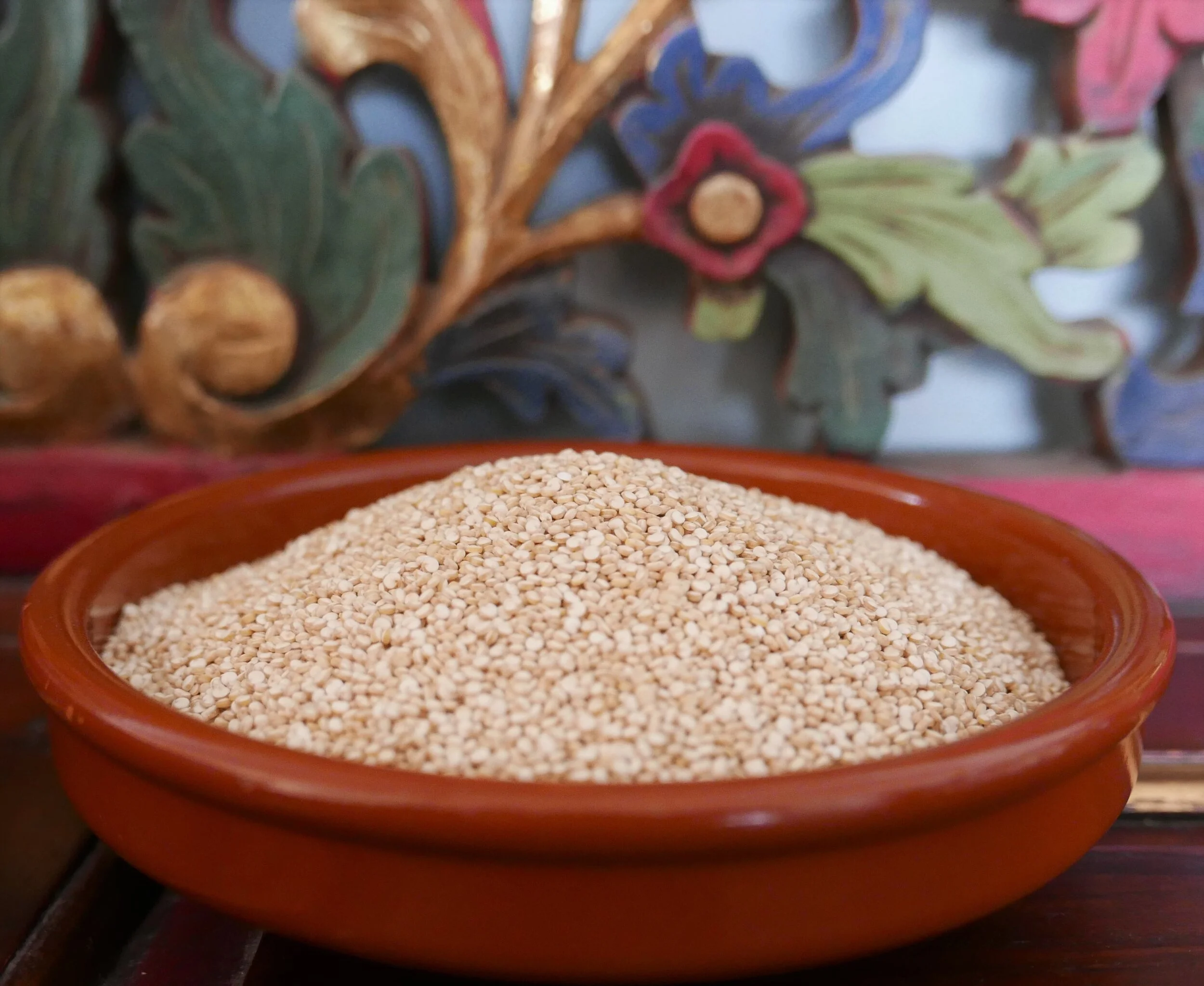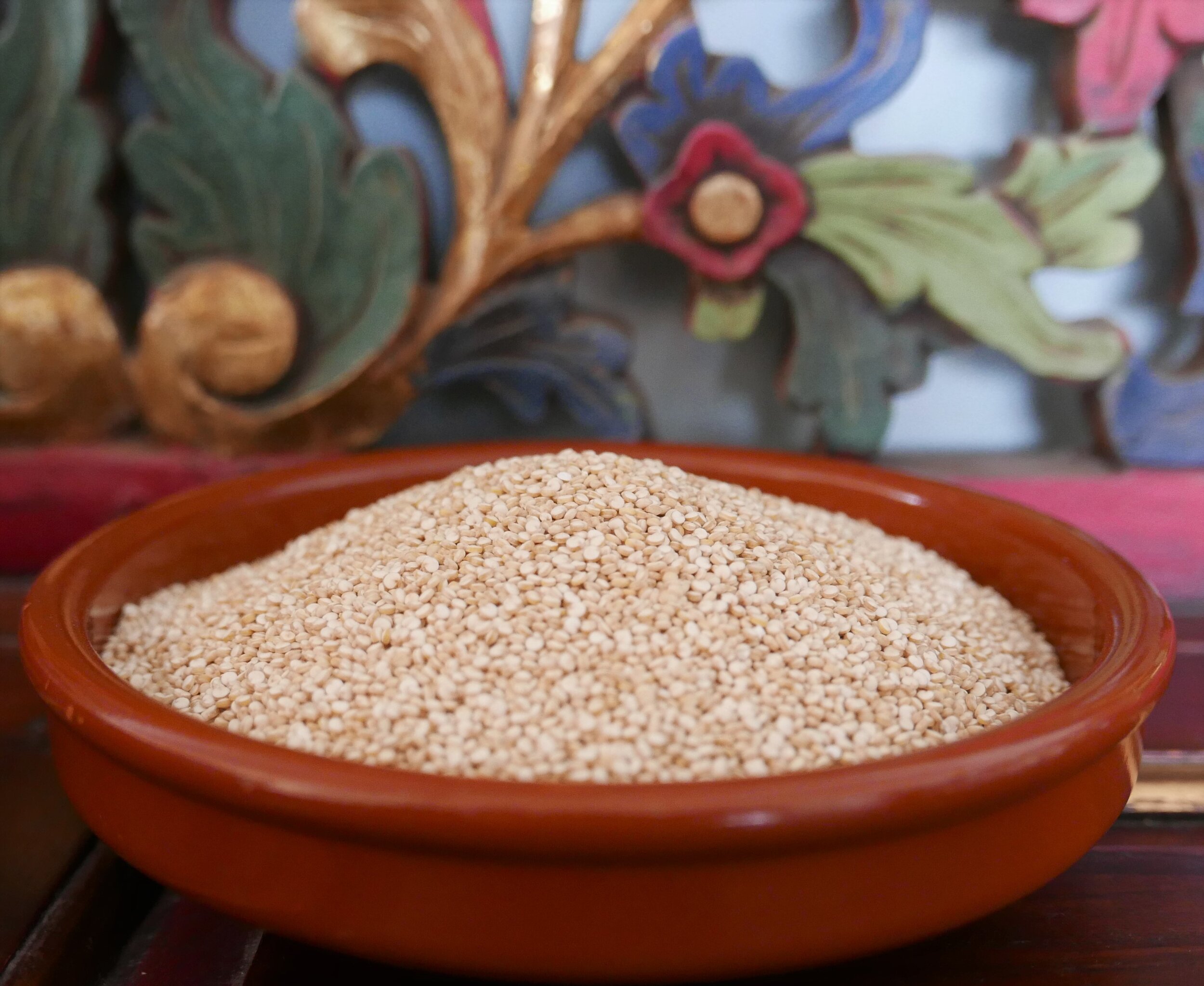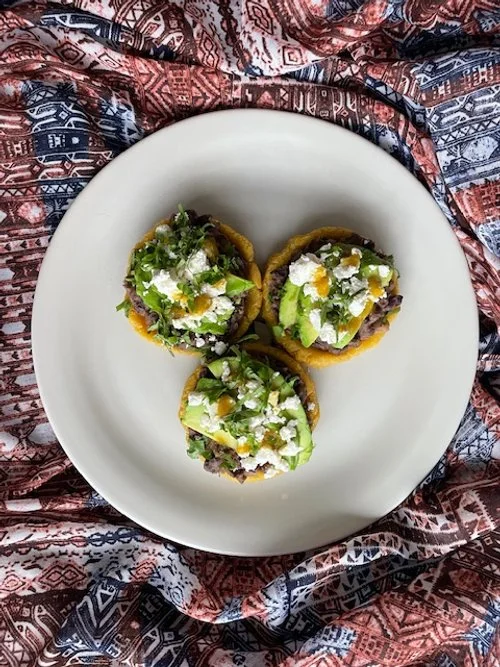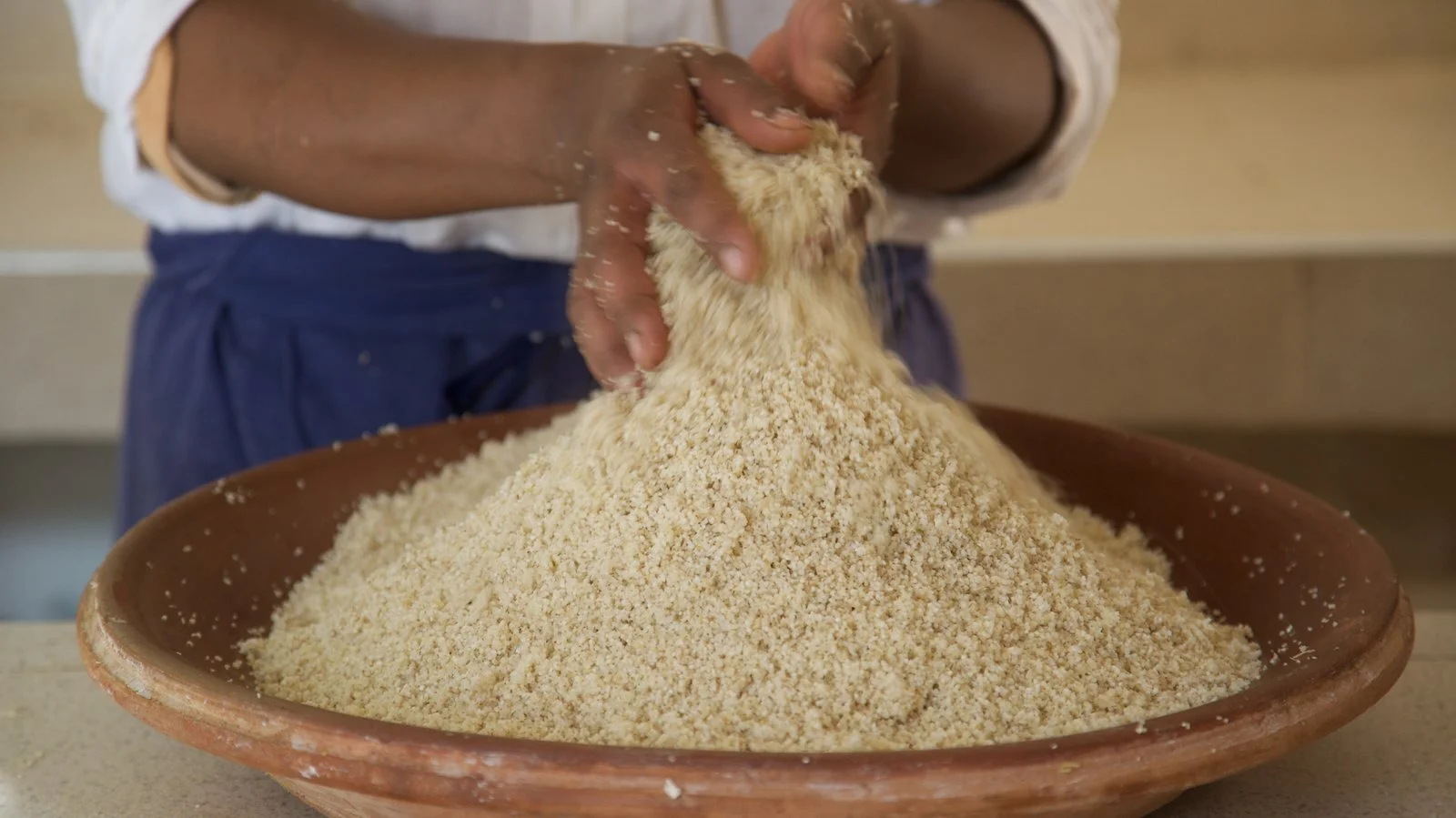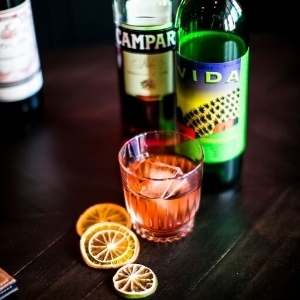explore the world through the universal language of food
Quinoa - The Superfood of the Ancient and Modern world
A cluster of purple flowering, over metre-high quinoa, is truly a magnificent sight to see. The goosefoot plant is closely related to beetroot, spinach and amaranth with edible leaves but most importantly, a nutrient-enriched seed.
What is Quinoa?
Quinoa is now known today as one of the most popular ‘superfoods’ and is available around the world. This pseudo-cereal is extremely versatile eaten as a grain, ground into flour and also made into dairy-free milk. It is a gluten-free plant-based protein that contains amino acids, fibre, vitamins and magnesium.
This ancient crop has existed for over 7,000 years, finding its roots in the Andes region surrounding Lake Titicaca in Bolivia and Peru. Kinwa (in Quechuan language, used by indigenous Andean people) held strong cultural and religious significance within the Incan empire. It was a gift to the Gods and was known as “Chisaya Mama”, the mother of all grains.
When the Spanish conquistadors arrived in the Americas in the 14th Century, they burnt fields of quinoa, banishing the use of the seed for religious ceremonies.
Quinoa Fields
Credit: Cristobal Demarta via Getty Images
Fortunately, quinoa is an extremely stable and adaptable crop, surviving in harsh environmental conditions with little water needed. There are many types of quinoa that have adapted over the years to the varying geographical areas along the Andes, however, the most exported quinoa from South America is the large white seed which we see on our supermarket shelves.
Both Peru and Bolivia contribute to 80% of Quinoa’s global trade, with Peru being the largest producer of the two. Quinoa is grown in dry climates and the surge of its popularity and price after 2006 saw certain varietals starting to be cultivated around the world such as the United States, Europe, Africa and Asia.
The United Nations declared International Year of Quinoa in 2013 to raise awareness of this important ancient crop and to bring attention and support to the farmers in Bolivia and Peru. Quinoa from Bolivia is associated with the name Quinoa Real, produced by 60% of the farmers and certified organic. Peruvian quinoa is broken down into the categories of organic, biodiverse, and supporting women’s livelihoods.
The Andean grains program in South America focuses on aiding poor communities that farm quinoa, in particular women who are the majority farmers of this popular seed. Due to the fact that only certain varieties are exported, the Andean Grains Program are focusing on indigenous strains and implementing them into a local school and hospital diet programs to ensure their long term survival.
Quinoa grows in dry cool climates and begins as an extremely leafy yet slow-growing plant. Sprouting to over a metre high, the quinoa plant begins to flower and most of the leaves fall off. It is at this point the seeds are ready to be harvested.
The stalks are cut and arranged in bundles that are interwoven to withstand strong winds in a formation known as “chujilla” (huts) which are then left to dry. Harvesting in South America is mainly done by hand and when the plants are dry enough, the seeds and seed heads are rubbed gently so the two separate.
The seed is coated in a saponin which is a natural protectant from insects and birds, however, it is extremely bitter. This coating is rinsed and polished away revealing the wonderful grain which we recognize as quinoa.
Quinoa is extremely versatile in cooking due to its texture and neutral flavour. You can create wonderful salads, risottos, porridges and even desserts that are vegan, gluten-free and high in protein.
I made some quinoa fish cakes with a mango chilli dressing if you want to try the recipe HERE
What is Couscous?
With North African origins of about 2000 years ago, couscous has spread around the world – not so much in many forms but in many dishes. In Berber, the word couscous means well-formed or well-rolled and it is an ingredient that has religious and spiritual significance. It is cooked at family celebrations such as weddings and is also eaten at the end of Ramadan. Its nutritional profile is minimal in protein and fibre, like pasta.
How is Couscous made?
Couscous is made from the product of wheat milling known as semolina (not flour) which is crushed into small granules. It is an ingredient that is extremely versatile, quick, and easy to cook and used in both sweet and savoury dishes. Although couscous is made most commonly from wheat, it is also found using millet, corn, sorghum, and barley.
Israeli couscous or ptitim is larger than the traditional type by using both semolina and regular flour, it has a chewier consistency and bite to it.
Traditionally, couscous would be handmade on a large flat plate where semolina is sprinkled lightly with salted water and plain flour. The mixture is rolled until the granules appear and are then sieved with dry flour to separate and obtain pellets of a similar size. This laborious process is repeated, and the couscous is then dried in the sun, stored, or cooked.
Couscous around the world
Couscous in Morocco is usually steamed to be cooked in special pots known as a couscoussiers where stock or stews can be made in the bottom vessel while the couscous is steamed on top, allowing it to maintain a light and fluffy texture. It can also be mixed with water and oil before steaming and then intermittently stirred over a period of time adding butter until the grains are fluffy and cooked. These days, instant couscous is conveniently available, and all is needed to cook it is right parts stock to granule, and an 8 – 10-minute wait.
Preparing Couscous in Morrocco’s Hight Atlas Mountains
Credit: JEff Kohler /NPR
Although it is not known exactly how and when it made its way to Tunisia, there is evidence around the 15th Century in the writings of Tunisian pilgrims, documenting a dish comprising of couscous, butter, beef and cabbage. From Tunisia, it journeyed to Spain by the Moors and also travelled to Sicily where it is commonly found as part of dishes on the west coast. It was either introduced to Sicily in the late 800’s or possibly in the latter part of the 15th Century.
Couscous dishes vary around the world. In Morocco, couscous is usually served with vegetables and a small amount of meat, in Tunisia they enjoy a spiced dish with fish, lamb or beef seasoned with harissa. Couscous is commonly prepared with chicken and chickpeas in Jordan and Syria. In Sicily, their couscous is a mixture of tomatoes, herbs and fresh seafood. They have embraced couscous wholeheartedly by celebrating a festival for it in San Vito Lo Capo every year.
Cooked in larger quantities, couscous is the basis of many dishes that are enjoyed in cultures where food is eaten, shared and enjoyed communally around the world.
Here is a Sicilian seafood couscous recipe to get you started….
Bread - A Short History
We have stopped travelling and wandering the globe (just for now) and are getting back to the basics.
From what I can see, almost everyone seems to be hunkering down at home and learning the wonderfully satisfying craft of baking – and I am so proud of you! From complex sourdoughs to banana bread and simple scones, bread, in any form is a true joy to make and a delight to eat.
Credit; Amaia Arranz-Ortaegui (npr.org)
An Everyday Staple - Bread
Bread has walked hand in hand with humans for over 14,000 years. The 2018 discovery of charred bread found at the site of Natufians in Northeastern Jordon revealed that these hunter-gatherer people settled down to make bread with wild cereals prior to exploring farming.
The Natufian culture existed in Epipaleolithic times, a period which rested in between the Palaeolithic and Neolithic eras. It was within the Neolithic period that the first agricultural revolution took place and people started to settle and farm rather than wander the land for food
Artisan Bread
Sourdough and artisan breads are products that people are now making and eating more of. We are embracing the technique of making our own leaveners which can be traced back to the ancient Egyptians who were also into beer brewing as depicted in paintings of that time. The story of the original creation of sourdough loosely talks about dough being left out as wild yeast in the air drifted into the mix. The bread baked from this dough was lighter, fluffier and tasted better.
A simple starter or sponge of flour and water, time and tangy fermentation are the building blocks of a naturally leavened bread. Throughout the world many cultures have been fermenting dough with local grains long before it was documented such as injera of Ethiopia made with fermented teff flour and kisra, a Sudanese bread made from fermented sorghum.
The process of bread making journeyed from Egypt to Greece, whose cuisine comprises of over 70 different types of bread both sweet and savoury, made from a variety of grains. The Greeks were the first real artisan bakers and bread was and is such a strong part of their culture.
As with many skills and ideas, the Romans learnt the art of bread making from the Greeks and mastered the art of kneading and developing new baking techniques, including the fermentation of grape juice, skins and all, which sped up the fermentation process.
Female Bakers, Thebes, Boetia, 6th Century BC (Louvre, Paris)
Credit; Bridgeman Images/Greece-is.com
Leading up to the discovery of yeast and how it reacted, barm, a foam that forms on the top of beer during fermentation was included in the process of baking bread, acting as a leavener and cutting down some time as opposed to making a starter from scratch. Bakers could not always be reliant on breweries for their barm so continued to make sourdough. In Austria, mass-produced yeast was developed by chemists, taken from the tops of fermenting brew, washed, dried and then pressed into cakes. Unfortunately, shortcuts were made and the product became bulked up with fillers.
The Invention of Dried Yeast
Charles Fleischmann and his brother Maximillian who were managing their family’s distillery in Vienna, travelled to the United States with a baker’s yeast they had been working on.
The brothers paired with James Gaff, a local distiller, to found the Fleischmann Yeast Company, based in Cincinnati in 1868. The yeast was compressed into small ready to use cakes and wrapped in foil. This was the beginning of the worlds first commercialized yeast that allowed people to bake with more consistency and less time.
The development of fresh yeast available to all was an achievement but the invention of dried yeast was a revolution. This new Active Dry Yeast did not need refrigeration and proved to come in handy for the US troops during WWII, enabling them to make their own bread in a small amount of time.
Fleischmann’s Yeast Poster
Credit; Science History Institute
The convenience of baking a faster-rising loaf of bread was a genius invention however did eventually lead to the downfall of quality nutrient-dense bread. Originally, flour was made by stone grinding the whole wheat kernel, resulting in whole wheat flour that contained the bran, germ and endosperm This flour was then simply sifted to remove any larger particles. The development of the steel roller mill sped up the process of milling wheat, however with this new process, the grain was separated resulting in a less nutritionally dense flour. It was a fast and efficient way to make larger volumes of flour and coincided with the Industrial Revolution of the 1900s.
Commercial Bakery.
Photograph: Fritz Goro/LIFE Picture Collection/Getty Images Photograph: Fritz Goro/The LIFE Picture Collection/Getty Images/TheGuardian)
With the lack of nutrition in this mass-produced flour, artificial vitamins and minerals were then added after it had been processed. The industrialization of bread was a lengthy development, facing the challenge of creating a stable food product that could last for more than a few days. Enter the introduction of chemicals and stabilisers to our once healthy loaf of bread. With loaves of bread all white, sliced, and readily available, people stopped baking at home and started buying this ‘enriched bread’ along with those horrid yet ingenious TV dinners.
Image; The Bakehaus, Singapore
However, all is not lost. We are turning back to old school traditions and hopefully realizing that food is the key to disease prevention and the cheapest medicine one can find. Sourdough is now trendy again - more than ever, but it can come at a high price if you compare it to your average loaf of bread at the market, yet it is higher in nutrition due to the long fermentation process and is much more satisfying to eat and digest.
Good sourdough takes time and effort or money but if you have the budget - it is totally worth it. Check out these The Bakehaus Loaves!!
Time is something we have a lot of these days, so have a go at making a sourdough but but if it seems all to troublesome you can always try baking a regular yeasted loaf with stone milled, organic flour. There are so many simple breads that take an hour or two to make. Like pita bread, damper or even scones - the possibilities really are endless!
Flex your baking skills, explore this extremely therapeutic hobby and always use the best quality flour your budget can allow. It will make all the difference. Honestly, trust me.
Negroni.... the taste on everyone's lips this week
Pour me a Negroni.
Make sure it's one part Campari, gin and sweet vermouth, stirred and chilled perfectly then poured on the rock - don't forget the orange rind!
Image: Ensof Photography
From it's humble beginnings in Florence, Italy around 1919... The Negroni, a classic cocktail is quite possibly the 'it' cocktail to drink at the moment - especially this week.
One day, Count Camilo Negroni needed a drink. His usual Americano cocktail consisting of Campari, sweet vermouth and soda just didn't have enough kick to it so he requested a tipple with a little more punch from the bartender, Fosco Scarselli. With the addition of gin and the subtraction of soda, the Negroni was born.
The classic Negroni has always existed but really took a turn when 2011 marked 'the year of the Negroni'. It was fantastic for Campari - for without Campari you can't have a Negroni. The marketing campaign of this wonderous classic cocktail turned into a yearly celebration - Negroni week.
Negroni week is a great marketing campaign, a genius way to sell a lot of Campari but it is also a fantastic fundraiser and has raised over $600 000 to various charities since it started in 2013. Each year, bars around the world will register for Negroni week and develop their own twist on the classic 20th Century cocktail and donate a percentage of each drink sold to their elected charity.
From that small request in Cafe Carsoni that spiralled into a worldwide marketing campaign which has built an international community for charity - who would have thought just one drink could be so powerful?
I'll drink to that.
Find out more at Negroniweek
Cover image credit: punchdrink.com
The Importance and Significance of Mole
After a year of living and travelling around Mexico, I don't believe there is a dish that is quite unique or possibly any more Mexican than mole.
I know that tacos are Mexico's most well-known and popular export, but nothing is as wonderful as a mole, made from scratch using nothing but local ingredients - the most significant are those wonderful combinations using some types of chillies that are only found in the country.
Mole is a word that is derived from the Nahuatl (the native language of the Aztecs) word ‘molli’ which means mixture or sauce. It is a dish that differs from region to region, reflecting ingredients that are in abundance locally and in season. It is argued that Mole was invented only after the Spanish arrived in 1520, however, there is evidence of traditional style moles such as Huaxmole, a dish using Guaje seeds, that originated in Tehuacan before the conquistadors.
The basis of all moles
Moles are an amalgamation of a few or many ingredients to create a unique flavour profile that is very distinct. Each ingredient is prepared individually to bring out the strongest flavour profile possible. The mole protein most commonly used is pork and chicken which is boiled initially with the herbs and spices, taken out, rested and then added to the final paste.
Most ingredients for preparation are either fried or dry roasted before and can be narrowed down to chillies, sweet, sour, spice and thickeners, however overall and in more detail, there are about 9 categories that make up a mole;
DRIED CHILLIES
Dried Chillies are always used in complex moles. They add heat, smokiness, sweetness, colour and depth to the sauce.
SPICES
Spices add complexity and aroma to moles. Black pepper, coriander seeds, allspice, cloves, cumin, anise and cinnamon are commonly used. Spices are roasted and ground to extract maximum flavour.
NUTS AND SEEDS
Nuts and Seeds are elements of mole that are reminiscent of Medieval Spain.
Almonds, walnuts, peanuts, pumpkin seeds and sesame seeds are added to the mixture to add richness and body. They are usually dry roasted or ground before adding.
THICKENERS
Are in the form of bread, tortillas or crackers are toasted dry or fried before grinding and slowly added towards the end of mole preparation.
VEGETABLES
Vegetables add both a sweet and sour element to balance out mole. Vegetables such as onions, (or those classified as vegetables in mole making) tomatillos, tomatoes and garlic are used as basic seasoning vegetables which are roasted or char grilled to impart a smokey flavour.
FRUIT
Both fresh and dried are added to moles to give both sweet and sour notes. Raisins and prunes are commonly used dried fruits as well as plantains. In manchemanteles, apples and pineapples are added at the end to finish off the mole.
FAT
In the form of rendered animal lard is traditionally used, however, modern recipes tend to use a fruity olive oil.
WATER OR MEAT BROTH
Is used to thin out the mole. Chilli water is also used after chillies have been roasted and soaked and the excess is drained off.
BROWN SUGAR LOAF / PILONCILLO
This sugar has a deep caramel earthy flavour will be added at the end of the mole to finish it off after the sweetness from the fruit and vegetables is gauged. White sugar can also be used.
CHOCOLATE
Chocolate is not used in all moles. It gives richness and earthiness to the mole. Commonly used chocolate is bitter and has cinnamon already mixed into it.
A Wonderful Story of Mole Poblano.....
Mole, well the infamous Mole Poblano is said to have originated in the central east part of Mexico in a state called Puebla. Apparantly, there was to be an impromptu visit from Bishop Manuel Fernandez of Santa Cruz (Oaxaca) to the Santa Rosa nunnery. The nuns couldn’t figure out what to cook.. they looked at the turkey running around the yard and raided their pantry of nuts, bread, chocolate, herbs and spices – and mole Poblano was born! Whether or not this story is true, it’s a fantastic story and mole has become a national historic dish.
Moles such as mole poblano are said to have originated in Mexico after the arrival of the Spanish Conquistadors (after 1520). This is evident in the ingredients that are used in moles such as native chillies, fruits and seeds combined with more exotic fruits, bread and nuts. Moles around Mexico vary from state to state and can use a variety of ingredients numbering from about 10-34!!
Moles are a combination of both Mesoamerican and Spanish influences and has resulted in many variations around the country. Notable types of moles around Mexico are those from Michoacan (west), Puebla (central east) and Oaxaca (south west). It is a dish that combines fruits, nuts, chocolate, herbs, chillies and spices that can paired with poultry or pork, and also red meat, however the latter is not traditional.
Mole in Oaxaca
Oaxaca, the land of the seven moles is one of the 31 states of Mexico located in the sothern part of the country. It is a state that is still to this day rich in strong cultural heritage and claims ownership to the development of 7 significant types of Mole, the most significant, being the Mole Negro, or Oaxacan Black Mole.
MOLE NEGRO Credit: Oaxaca x Amor
Mole Negro Oaxaqueño is a black sweet stew that is complex in flavour and traditionally ground on a metate (Mexican version of a mortar and pesel where the surface for grinding is flatter). Mulato dried chillies are used in this version as they are fruitier and contain significantly more flesh. Traditionally made with seasoned chicken and flavoured with garlic, white onion, mulatos, tomatoes, cloves, all spice, fresh thyme, marjoram, mexican oregano, lard, seasame seeds, peanuts, almonds, raisins, plantain, corn tortillas, cinnamon and mexican drinking chocolate.
Mole Verde (Green Mole), is a version of Mole you will find in many different regions around Mexico. Variations of this type of Mole will depend on the availability of ingredients in that particular region. The Oaxacan green mole has a rough or more 'rustic' consistency with a more complex flavour using green chillies, herbs, green tomatoes, garlic and seasonal greens. It is traditionally cooked with chicken or pork and is served with chochoyote (masa dumplings).
Red Oaxacan Mole (Coloradito) is a sweet mole made with guajillo or chilcostle chillies, tomatoes, lard, mexican oregano, cloves, allspice, onion, garlic, plantain, bread, Mexican chocolate, sugar and cinnamon (cannela). The cinnamon creates a wonderful red tinge to this version of mole which contains complex flavours and presents itself in a rather thick sauce. The leftovers from this mole are used to make enchiladas.
Mole Amarillo (Yellow Mole) is more the colour of a light red and can vary depending on the chillies used. Guajillos are usually readily available therefore commonly used. Amarillos, chilhuacles, chilcostes and costeños were once used in older recipes and are unique to Oaxaca. As well as chillies, Amarillo Mole contains cumin, green tomatoes, onion, allspice, cloves, masa and coriander.
Mole Rojo (Red Mole), is the spiciest of all the moles. It includes ancho and guajillo chillies as well as almonds, raisins, star anise, cloves, cinnamon, pepper, oregano, epazote, bay leves, garlic, salt, chocolate and masa harina.
Mancha Manteles (Tablecloth Stainer), is a mole that is both sweet and sour and is bright red in colour. Ancho, Guajillo and costeño chillies contribute to this mole's vibrant colour and the unique flavour is a combination of walnuts, amlmonds, tomatoes, sesame, cinnamon, cloves, oregano, peppercorns and raisins. The final dish is then finished with apples and pineapples.
Mole Chichilo (Black Mole), is a different style mole with the stock predominately flavoured by beef. Chilhuacle chillies are used as well as mulatos, pasillas, avocado leaves, cumin seeds, garlic, allspice, potatoes, onions and tortillas.
Other Mexican Moles
We cannot forget the many other variations of moles around the country. That may or may not be classified as a mole such as Chimole, from Yucatan which contains black recado (a mixture of strong, smoky blackened spices which can include arbol, ancho, achiote, cloves, epazote, and Mexican oregano.
Mole Xiqueño from Xico in Veracruz is brown and black in colour and contains ingredients such as tortillas, mulatas, pasillos, chocolate, nuts and xolonostce or prickly pear cactus.
Huaxamole, Guaxamole or Mole de Guaje - whatever you call it is traditional to mixteca poblano. The string beans in this type of mole are known as guaje. It is one of the more traditional prehispanic moles originating in Tehuacan.
The list of mole variations goes on and on and with history and traditions, every family has their own secret ingredients that are significant to them in some special way. Each mole that is prepared has a story, a tradition and this is the most important, the most wonderful, and significant thing about mole. The most unique and iconic dish of Mexico.

